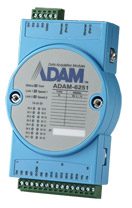
Posted to News on 29th Nov 2016, 14:42
Pico-controllers and IEC 61499 software for distributed control
Advantech ADAM pico-controllers and IEC 61499 function block programming language have been used to create a distributed system for testing control algorithms for managing smart grids.

Traditional electricity grids are pretty 'dumb'; they continuously send out specific amounts of electricity until some engineers tweak that amount to meet the needs of the users. Smart grids, on the other hand, are designed to monitor continuously the electrical supply and usage so they can adjust the generation and consumption of power, manage storage of surplus electricity and, therefore, save energy, reduce waste and improve reliability of the power supply. If some of these functions are still in the future, researchers are already building smart grids in the laboratories.
Advantech integrates the advanced technologies of industrial computing, networking, data acquisition and automation, and provides the means for implementing real-time monitoring, control and data analysis of power generation, transmission, storage and distribution. Advantech works with the traditional power generators, such as fossil fuels, nuclear and renewable energies such as hydro, as well as distributed energy sources like solar, wind, gensets and geothermal that are often integrated into city grids.
System requirements
At the University of Auckland, New Zealand, Professor Valeriy Vyatkin and his team set about trying to find a solution to one of Smart Grids' inherent problems, that is, economic dispatch. Economic dispatch is the allocation of demand to individual generating units on line to effect the most economical production of electricity, based on their actual or offered pricing. Nuclear, coal, gas, oil, wind and solar all have a unique cost based on their capital costs and their operating costs. Suppliers will offer energy on a daily basis to the deregulated markets, and distributors and wholesalers have to order it based on their estimations of usage. They then have to manage their supply and their demand to avoid penalties for over- or under-usage, and they try to minimise load shedding, which is always possible but results in lost revenue and irate customers.
To implement economic dispatch, the engineers at Auckland wrote an algorithm using the IEC 61499 function block language. This algorithm is set up in a number of intelligent 'agents' each independently working towards the common objective - minimising the total cost of operation of generators.
The use of IEC 61499 enables system-level design and testing of the entire system, while the system-level design simplifies distribution and deployment and allows for easy reconfiguration and maintenance of multi-agent software. The developed industrial agents are platform-independent and interoperable.
To test this algorithm the engineers programmed five Advantech ADAM-6600 pico-controllers each with an 'agent' as if each was connected to a different type of power generator. The cost of generation from each agent is then monitored and, depending on the consumer demand, a decision is made on sourcing.
System diagram:

There are already more than one million ADAMs installed around the world, monitoring a huge range of devices; now, with the ADAM-6600, the information received from these devices can be used to make decisions and take actions - and take control. Advantech is leading the development of low-cost, distributed control systems with its ADAM-6600 range of Ethernet-based, ARM Cortex powered pico-controllers. Each is programmed with the IEC 61499 control software, which enabled the team at Auckland to simply drop their function blocks onto the appropriate ADAM. The links between each ADAM were already programmed in the function blocks.
The latest technology enables a powerful but small controller to make many local decisions in real-time. Placing intelligent control systems at remote nodes in the network has many advantages: avoiding the problems of communication network breakdown, the inevitable latency and, of course, the cost of a large, centralised system with all the problems associated with a too-big-to-fail single point. The inherent strength of a distributed energy supply is here enhanced with an inherently strong distributed control system.
Benefits
With energy supply becoming ever more complex, all involved in the supply chain can take advantage of the latest technologies to deliver power in the most efficient manner. The research being carried out at Auckland University is an important step in that direction and, by using Advantech ADAM-6600 distributed controllers with IEC-61499 to test their theories, their research can be tested using real-world devices.
Follow the link for more information about Advantech's ADAM pico-controllers.






























